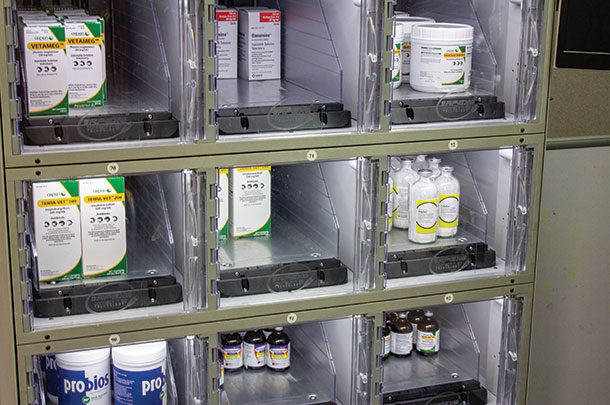One of those changes is the phrase “supply chain issues,” which has become ingrained in our vernacular. Between COVID-19 and the war in Ukraine, global supply chain weaknesses in many industries have been exposed, and the pharmaceutical industry is no exception. But for those of us on the front lines of food production, what do we do when supply chain issues create food chain issues?
There is a broad array of reasons for backordered or unavailable cattle pharmaceutical product. Much of the challenges are due to globalization. The plain and simple fact is: Many of the raw active ingredients in our pharmaceutical products are produced abroad. Plants that manufacture the pharmaceutical ingredients must be federally inspected. When those plants lie beyond our shores, particularly those located in China where COVID-19 is surging again, routine inspections are not yet occurring, and so some plants have lost their certifications.
In many cases, ingredients headed for the North American market are frequently delayed on cargo ships waiting to make port and be unloaded. In some cases, the ingredients that do make it ashore struggle to move overland to the manufacturing centers. Additionally, when there is overlap with active ingredients used in human medicine, the available resources will be used to meet those needs first. Products that have higher concentrations of active ingredients, such as dry cow preparations, have been hardest to meet the demand for with the few remaining suppliers.
But the issue is not just with ingredients. The same challenges apply to the drug packaging and labeling. When it comes to packaging such as the intramammary infusion tubes, not having access to a consistent supply of plastic tubes to package the finished product in has also created lapses in manufacturing. The mass effort to supply the globe with COVID-19 vaccines has also dipped into the capacity to produce other vaccines in some unlikely ways, including creating a shortage of glue to affix the product labels.
Much shorter than the discussion about the causes is the discussion of what veterinarians and producers can do to mitigate these supply struggles. In the immediate term, the answer is: not much short of looking for alternative therapies. In the bigger picture, however, this is an opportunity for us as an industry to examine how, when and why we decide to treat with antibiotics.
What
Veterinarians learn early on in school that there are three types of cases we will see.
1. Those that will get better no matter what we do. Stay out of the way of those cows.
2. Those that will never get better no matter what we do. Do not waste time and resources on these cases, for the sake of the cow or the producer, but learn how to better prevent them – and for those we cannot prevent, improve our systems to find them earlier when the outcome would be more favorable.
3. Those cases that can be improved with intervention. Focus on these cases and find the right combination of treatment, management and supportive care to realize the improved outcome.
A thorough physical exam along with even some basic on-farm diagnostics can go a long way to helping us decide which of the three cases we are looking at. How many cases do we treat without ever establishing a diagnosis? Even when the diagnosis may be obvious, effective management of many cases is possible and perhaps even desirable without reaching for an antibiotic. Great examples of this are uncomplicated scours in calves and retained placenta in fresh cows. In the case of scours, data suggests that scours calves who are not systemically ill (no fever, etc.), do not have blood in their stool and are still drinking milk do not require antibiotic therapy. Instead, oral or IV fluids and digestive supports such as probiotics could be the treatments of choice.
In the case of retained placentas, these animals have not yet developed an infection, and many RP cases will not develop into metritis, especially if we can get the placenta to pass. Like scours, supportive therapy is likely to be the treatment of choice, with a goal of supporting the cow’s own immune function and correcting any metabolic imbalances or dehydration.
How
These supply chain issues should serve as the impetus to improve our treatment decision-making even among the conditions that may benefit from therapy. Although producers often prefer not having to make choices, clinical mastitis is a great example of where straying from the “all or none” approach really makes sense. In many cases, two-thirds or more of mild clinical mastitis cases may not benefit from antibiotic therapy. A simple on-farm culture diagnostic can help make this valuable treatment decision.
When
In this case, let’s consider blanket treatment of calves at weaning. Undoubtedly, weaning is an extremely stressful time in an animal’s life, and we know stress can contribute to the development of diseases. Yet how should we defend the need to prophylactically treat all animals to have a positive animal care outcome?
At a minimum, judicious pharmaceutical use would mean we should be asking, “How we can improve the process of weaning in ways that lower the stress? How can we boost the immune capabilities of the calves, and how can we manage the environment in a better way to lower exposure to pathogens? Are we using pharmaceuticals as a temporary Band-Aid or a long-term crutch when we should be considering management solutions instead?”
Why
Dry cow therapy is a great opportunity to look at the motivation behind why we choose to treat. The milk quality goal of every dry cow program is twofold. Firstly, cure any existing infections in cows going dry. Secondly, prevent new infections from occurring over the dry and periparturient period. In this example, we will tackle them both separately.
Treat for a cure: Most dry cow tubes have a label claim only for curing existing infections. In fact, this is one of the driving factors behind why it is extremely difficult to defend blanket dry cow therapy. With the average somatic cell count (SCC) in North America continuing to decline, most cows and quarters will not be infected at dry-off. Responsible antibiotic use would be to use dry cow tubes for the indication which they have a label claim, which would mean only treating those animals with an existing infection.
Prevention: When it comes to preventing new infections, there are two primary times in the dry period when new infections occur. One is at or immediately around the time of dry-off, and the other is at or around the time of calving. While the quarters we infuse with antibiotics at dry-off can have detectable and in some cases even violative residues in the milk at the time of calving, these residual levels would not be at nearly high enough concentration to inhibit the growth of mastitis pathogens at the time of calving.
In the case of new infections immediately post-dry-off, we are probably better off to keep the bacteria out of the gland in the first place than rely on antibiotics to inhibit pathogens that gain access to the gland. Teat sealants help provide a barrier to mastitis-causing pathogens gaining access to the mammary gland. External sealants that are dipped onto the teat try to achieve this by placing a film over the end. Internal teat sealants are meant to fill the teat sinus and teat canal. Beyond that, management factors such as post-dry housing conditions, milk production at dry-off, teat health and even aseptic infusion technique probably play a bigger role in prevention than any product we chose.
Note on over-the-counter (OTC) pharmaceuticals: Some of the generic label penicillin products and tetracyclines have faced significant supply chain issues. Many producers have relied on these drugs because some formulations are available OTC, which has made them easily accessible without veterinary oversight. While potentially both painful and inconvenient to us, supply chain issues can serve to help wean us off OTC products.
While there is still a place for these drug classes in treating some of the common cattle diseases, the time is very near where OTC antibiotic sales will soon be a thing of the past. That should be viewed as a positive, as drugs such as penicillins and tetracyclines with extremely old labels often need to be used off-label to be effective treatments. Because these drugs also require large volume doses of drug, and because they have “long-acting” forms, these classes are also frequently residue risks.
Most dairymen and women are acutely aware of the current and ongoing issues with securing a supply of certain pharmaceutical products for use on cattle operations. While these shortages and the factors causing them are largely out of our control, rather than wait for the world to “normalize,” there are lessons we can take away from this situation that will allow us to be better stockmen and women than we were before the pandemic.







